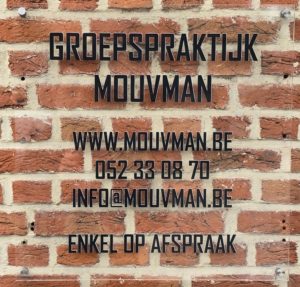Mouvman:
Physiotherapists
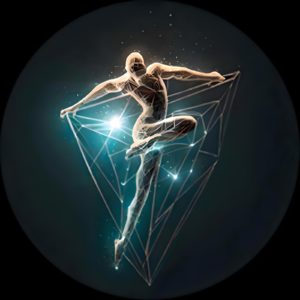
INTRO
Our practice is one contemporary physiotherapy practice where you go can for physiotherapeutic guidance of health complaints . The practice is established at Buggenhout-Opdorp in the center of Flanders and bordering on Malderen , Lippelo and Sint-Amands .
We are a dynamic team with a good mix of experience and youthful enthusiasm . Each member of our team will follow you according to his or her specific skills as accurately as possible in your recovery .
This gives you the guarantees that, in consultation with you and your attending physician, the most successful recovery process is always chosen.
THERAPY

Shockwave therapy
Radial Shock Wave Therapy (RSWT) involves the use of pressure waves directed from outside the body locally on the body. The waves are converted into kinetic energy on the separation of tissues with different densities (e.g. bone-tendon tissue). This therapy has its origins in the treatment of kidney stones ( lithotropia ) and is considered a safe, non-invasive method of treatment.
What is treated with RSWT?
Proven effective for heel spurs, tennis elbow , Achilles tendinopathy , shoulder tendinopathy ; calcifying shoulder tendons, patellar tendinopathy ; treatment of myofascial pains (Trigger Points).
Number of treatments ? Frequency ?
From 6 to 9 treatments with an interval of 5 to 7 days (maximum 10 days). A treatment takes about 5-15 minutes.
Is the treatment painful?
The treatments are uncomfortable, but well tolerated by everyone.
Are there side effects?
There may be some skin irritation or swelling. These side effects usually disappear within a week after treatment.
How does the device work?
A radial shock wave is generated pneumatically and is transferred into the tissue to be treated. The pressure waves cause a local increased metabolic activity and modify the biochemical environment. This process stimulates the healing process and also provides pain relief.
How fast does it work?
Most patients already feel a marked improvement after the first treatment. Some patients will only feel a difference after the third treatment. The recovery process is accumulative and patients continue to experience improvement for several weeks after stopping treatment. Because cells are broken down and rebuilt, the maximum result is usually felt after 12 weeks after the first treatment.
Why use radial shockwave therapy?
- Quick and efficient
- a very interesting option instead of surgery, which requires a longer rehabilitation time as well as a longer absence from work, loss of income and a reduced quality of life during the convalescence period.
- Limiting the use of medication
- Limiting the use of corticosteroids or repeated injections.
- Currently often used too exclusively when other interventions have failed.
- interesting therapy option for athletes who want to resume their sporting activities but continue to suffer from chronic pain.
Is There Clinical Evidence About Radial Shockwave?
Yes. More and more studies with good research methodology are being published that better and better demonstrate the clinical relevance of RSWT in well-defined disorders.

TECAR
TECAR stands for ‘transfer of energy via capacitive and resistive electrodes’.
In therapeutic use, this means that moving electrodes are used that provide local energy transfer. This creates either an electric field (capacitive treatment) or an electromagnetic field ( resistive treatment).
By creating these fields one obtains:
- An improved permeability of the cell membrane
- An increased intra- and extracellular ion movement
- The restoration of the chemical and electrical balance in the cells
- Stimulating mitochondria to produce more ATP
- Generation of endogenous heat in the tissues (diathermy)
- Vasodilation
- Stimulation of the lymphatic system
- Endorphin release
Results:
The TECAR therapy accelerates tissue repair. It also has anti-inflammatory, pain-reducing and muscle-relaxing properties. It also brings about a mobility improvement.
This therapy is indicated for:
- Muscle disorders
- Contractures
- Bruises
- Scar growths
- Edema
- Sprains
- Carpal tunnel

Lymphatic drainage
Lymphatic drainage is a form of therapy that aims to improve and accelerate the natural drainage of lymph fluid, especially where excess lymph fluid accumulates under the skin. This can be done by manual compression ( ie using the hands of the therapist who tries to get the lymph flow going better with appropriate pressure and sense of movement) and/or via a multi-chamber device that drains the deep veins ( lymphamat ).
What is Lymph and the Lymphatic System?
The lymphatic system is a second vascular system, next to the circulatory system, that ensures the removal of certain waste products from the cells of the body. Lymph flows in the lymph vessels , like blood in the circulatory system. Lymph contains approximately the same components as blood plasma, but has a higher concentration of proteins. The lymphatic system consists of lymphatic vessels, which converge in lymph nodes (also called lymph nodes).
Body cells need nutrients to adequately perform their function. These substances are supplied by the blood vessels. The wall of the blood vessels is porous at the level of the cells, so that the substances can easily emigrate to the space between the cells. The cells take the substances they need and deposit waste products in their place. Most of these substances can return through the vein wall back into the veins to be transported to the organs. However, some substances, such as proteins, are too large to immigrate through that wall. These are taken up by the lymphatic vessels because of their hydrophilic nature: they are attracted to water, of which lymph largely consists.
The lymphatic system is also responsible for the human immune system. White blood cells and other immune cells are thus transported to all parts of the body along these lymphatic vessels and glands.
What are the causes of lymphedema (fluid retention)?
- Secondary lymphedema to tumor resection:
Cancer cells can metastasize in this way. Therefore, often to prevent metastasis, the nearest glands are removed when the tumor is removed. However, this means that the lymphatic system no longer functions as before. Proteins, being hydrophilic, will remain in the intercellular mass and attract moisture. This gives a chain reaction, because the water also attracts new proteins. This gradually creates a swelling in the limb or part of the trunk that has to be drained by these lymph nodes. - Congenital Lymphedema:
Some people suffer from a “lazy” lymphatic system from birth. This is most apparent from puberty onwards. The lymphedema can occur in several or in one part of the body. - Edema of nose-throat ear (e.g. sinusitis):
This is basically an accumulation of fluid in the sinuses. - Edema due to trauma
- Edema of rheumatic origin
- Edema due to venous stasis
- Edema of the central nervous system (e.g. multiple sclerosis)
- Edema due to internal diseases
Are there any contraindications?
- Tumor present
- Organ transplants
- Infections
In consultation with the doctor, lymphatic drainage may be indicated or contraindicated :
- Acute flare-ups of asthma
- Heart patients
- Pulmonary emphysema
- Thyroid problems
- Neurovegetative imbalance
What does the treatment consist of?
Manual lymphatic drainage will always be used as a therapy, because it involves total drainage: MLD consists of emptying the glands, as well as stimulating transport through the lymphatic vessels. This can possibly be supplemented with compression therapy. The deep veins are drained in a pleasant way through a multi-chamber device, which lowers the venous pressure.

Myofascial muscle pain
Myofascial therapy or trigger point therapy is a method of treating pain or movement complaints through muscles ( myogenic ) and/or connective tissue (fascia).
Small hardenings, “knots”, can develop in muscles for various reasons: myofascial trigger points. A trigger point is a very pressure-sensitive area in a muscle with a diameter of about ½ -1 cm. Simultaneously occurring complaints of someone who suffers from trigger points are:
Pain:
The pain caused by trigger points can be sharp , stinging or can be continuous nagging and /or gnawing.
Muscle stiffness (hypertonia) with muscle shortening:
Due to the creation of trigger points in the muscles, the muscle tissue reflectively contracts . The patient experiences this as a painful and paved zone in the concerned muscles .
radiating pain:
Very characteristic for a trigger point is the radiating pain : the pain caused by trigger points is usually felt in a different place than where the trigger point is located. Usually the cause of the pain complaint can be found in a muscle at a distance from the pain zone.

Neuromotor rehabilitation
Neuromotor rehabilitation stands for the rehabilitation of neurological and motor functions by means of exercise therapy.
Neurology is a medical specialty mainly concerned with the diagnosis and treatment of diseases of the brain, spinal cord and nerves. In addition, muscle diseases are also often included in this domain.
Neurological disorders can develop both as a progression (e.g. Multiple Sclerosis, Parkinson’s disease, muscle diseases, …) and can occur suddenly (cerebral haemorrhages and infarctions, brain traumas due to falls, accidents, …).
The symptoms caused by neurological diseases are very diverse and can even differ greatly from person to person. All neurological symptoms arise from a disturbance in the proper functioning of the brain, nerves, spinal cord or muscles and can have different consequences on the neuromotor level. For example, muscle strength, sensitivity, coordination and balance may be affected. Spasticity or paralysis may also occur.
Neuromotor rehabilitation is one of the main interventions in the treatment of neurological disorders and their symptoms, in addition to medication, tips and advice to better cope with the condition or possible surgical intervention.
Complaints related to neurological disorders are: Headache, back pain, sensory disturbances, paralysis and dizziness.

Vestibular rehabilitation
Balance problems can arise from a variety of causes. Depending on the origin of the dizziness/balance disorders, the correct treatment method will be chosen.
Benign paroxysmal positional vertigo (BPPV) :
Benign Paroxysmal Position Vertigo/Dizziness (BPPV) is characterized by acute vertigo that occurs during movements, for example when lying down or getting up from a lying position. The vertigo is very intense, but lasts for a short time. Sometimes the dizziness is accompanied by nausea. Repetition of the rapid head movements reduces or removes the complaints.
BPPV can occur after a head injury, ear surgery, an inflammation or perfusion disorder of the inner ear or after prolonged bed rest. In most cases, however, there is no clear cause.
Treatment will consist of the Eppley maneuver or the modified Eppley maneuver or other maneuver depending on the range of motion vertigo. These are maneuvers in which the therapist gently returns the stones to their normal position. Improvement occurs very quickly. These methods are effective in 80% of cases. If this is not effective, a switch is made to specific Brandt-Daroff exercises.
Cervical Dizziness:
There are two underlying reasons why this type of dizziness can occur. Usually it concerns injuries of the neck (eg whiplash, vascular insufficiency). Information to the brain from the neck regarding posture is incorrectly passed on to the brain. As a result, incorrect information is returned to the postural muscles to adjust the posture. The complaints are constantly present and are aggravated by turning the head. Complaints have a spontaneous onset or are the result of trauma.
Rehabituation Training :
The literature has shown that certain forms of dizziness (particularly peripheral vestibular loss) and balance disorders can be effectively treated with vestibular rehabilitation. Forms that can cause peripheral vestibular loss include vestibular neuritis, labyrinthitis and loss of one or both balance organs. Rehabilitation training consists of specific exercise therapy. This is often a combination of the so-called Cawthorne Cooksey exercise therapy and balance training. Vestibular rehabilitation aims to facilitate the ventral compensation, adaptation and substitution mechanisms in order to reduce vertigo and balance disorders. In addition, vestibular rehabilitation aims to improve balance and ADL skills and to reduce anxiety and uncertainty.

MDB
Fascia Therapy Danis Bois method(DBM)
Fascia therapy is a form of treatment and guidance for pain, movement and functioning disorders of both a physical and/or psychological nature. The fascia therapist offers efficient solution options by using sensory manual techniques, sensory exercise therapy, introspections (meditations) and specific coaching based on knowledge and insights from the pedagogical world.
All parts of the body are connected to each other through fascias or various connective tissue structures (muscles, bones, tendons, organs, ligaments) that hold the body parts together. (biotensegrity)
The fascia therapist works on this level to solve various blockages, these being structural or psychological.
The therapy consists of the following different components:
- The manual part in which the patient lies on the treatment table and the therapist uses soft tissue techniques to check the tissue for blockages/tissue tensions and what nature they are, in order to then try to solve them and restore the mobility of the tissue.
- The educational exercise. Here we go to the manual part to teach the patient specific movements in order to reintegrate the loosened tissues into the whole of the body.
- The conversation with the patient. After the treatment, we sit down with the patient to talk about what he has experienced and felt. The emphasis here is on the patient’s awareness of his own body.
Fasciatherapy is a form of treatment that appeals to the self-regulating systems of the body through gentle techniques, sensory movements and the awareness of the patient’s body.

Dry Needling
Dry needling is an invasive procedure in which a fine needle or acupuncture needle is inserted into the skin and muscle. It targets myofascial trigger points ( MTrPs ), hyperirritable spots in the tense ligament of skeletal muscle and palpable as a nodule. Dry needling with trigger points can be performed at the superficial or deep tissue level.
Dry needling has been shown to immediately increase pressure pain threshold and range of motion, decrease muscle tone, and reduce pain in patients with musculoskeletal (myofascial) disorders.
The mechanisms of action include :
- Local twitch response: Dry needling can induce a ‘local twitch response’, which is an involuntary spinal reflex that results in a localized contraction of the affected muscles treated with dry needling. Local twitching can lead to changes in muscle fiber length and tension and stimulate mechanoreceptors.
- Effects on blood flow : Sustained contraction of tense muscle bands at trigger points can cause local ischemia and hypoxia. Dry needling causes vasodilation in the small blood vessels, leading to increased blood flow to the muscles and oxygenation, resulting in muscle relaxation.
- Neurophysiological effects : Dry needling produces local and central nerve responses to restore hemostasis at the trigger point site, resulting in a reduction of both central and peripheral sensitization to pain.

Back training / Ergonomics
Within our practice, relevant information is provided (instruction) about the correct use of your back in the case of acute back pain, depending on your back pain. You will then be thoroughly trained in performing the posture and movement patterns that are correct for you for your daily life (scholing), after which you proceed to training the load capacity of your back (functional re-education). Ergonomics is the scientific discipline concerned with understanding the interaction between humans and other elements of a system. It is the profession that applies theory, principles, data and methods to design in a way that optimizes human well-being and the overall performance of the system.
Supportive therapies

Electrostimulation
The therapeutic use of low-frequency modified electrical impulses to stimulate the skin and subcutaneous tissue. Is used for muscle injuries, as well as for neurological failure of muscles or sensory tissue.

Cryotherapy
Cryotherapy stands for the therapeutic use of cold. This form of cold therapy can be used analgesically, anti-inflammatory, vasomotor or neurologically.

Ultrasound
Ultrasound uses high-frequency sound vibrations. This therapy can be used if there is a tendon injury, muscle injury, or connective tissue contractures (shortening/contraction) such as joint capsule or scar adhesions.
Practical agreements
Consultations are by appointment only from Monday to Friday. On Monday and Wednesday from 8 am to 7.30 pm, Tuesday, Thursday and Friday from 8 am to 8 pm. Home visits are carried out by us if the patient cannot move for medical or social reasons within a radius of 7 km around the practice.
You can always call for an appointment on 052/33 08 70. If you hear the answering machine, clearly state your name, your message and your telephone number. We will call you back as soon as possible.
- The doctor’s referral
- A sticker of your health insurance fund , private insurance , industrial accident insurance , …
- A towel to lie on
- All documents or digital data carriers that are useful are for your health condition at bars : RX photos , …
Notify us as soon as possible, at least 24 hours in advance. We keep the agreed time free for you and are forced to charge this if you do not notify us in time. (statutory regulation)
Treatments that are refunded :
- Intake interview with verbal and visual instruction
- Schooling
- Manual actions, lymphatic drainage, TENS, Tecar , …
What is not refunded :
- Treatments without prescription
- Exercise equipment that is not returned within the agreed term or that is damaged due to insufficient care.
- Bracing and ( kinesio ) taping
- Myofascial material (Dry needling)
- Cold spray
- Shock wave therapy
If cash payment is not possible, we accept a transfer within five working days, as well as payment via the payconic app. In the event of non-payment, we are obliged to charge administration costs and late payment interest after the second reminder. You can also request a payment arrangement per consultation or with a different periodicity at the start of your treatment.
According to the law on the practice of medicine, your certificates for the health insurance fund, the insurance company, the work, etc. are given with your last treatment after payment of your bill.
KINE
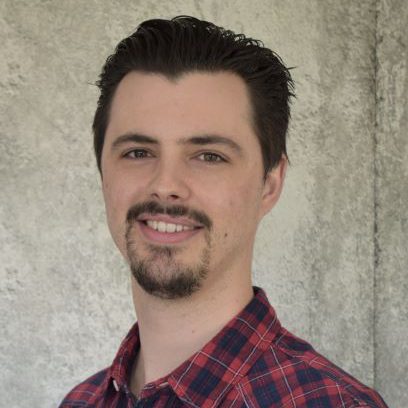
Killian Borms
Master’s degree in neurological physiotherapy in 2020
Specialisations:
- Neurology
- Shockwave therapy
- Fasciatherapist
- Dry Needling
- Myofascial complaints
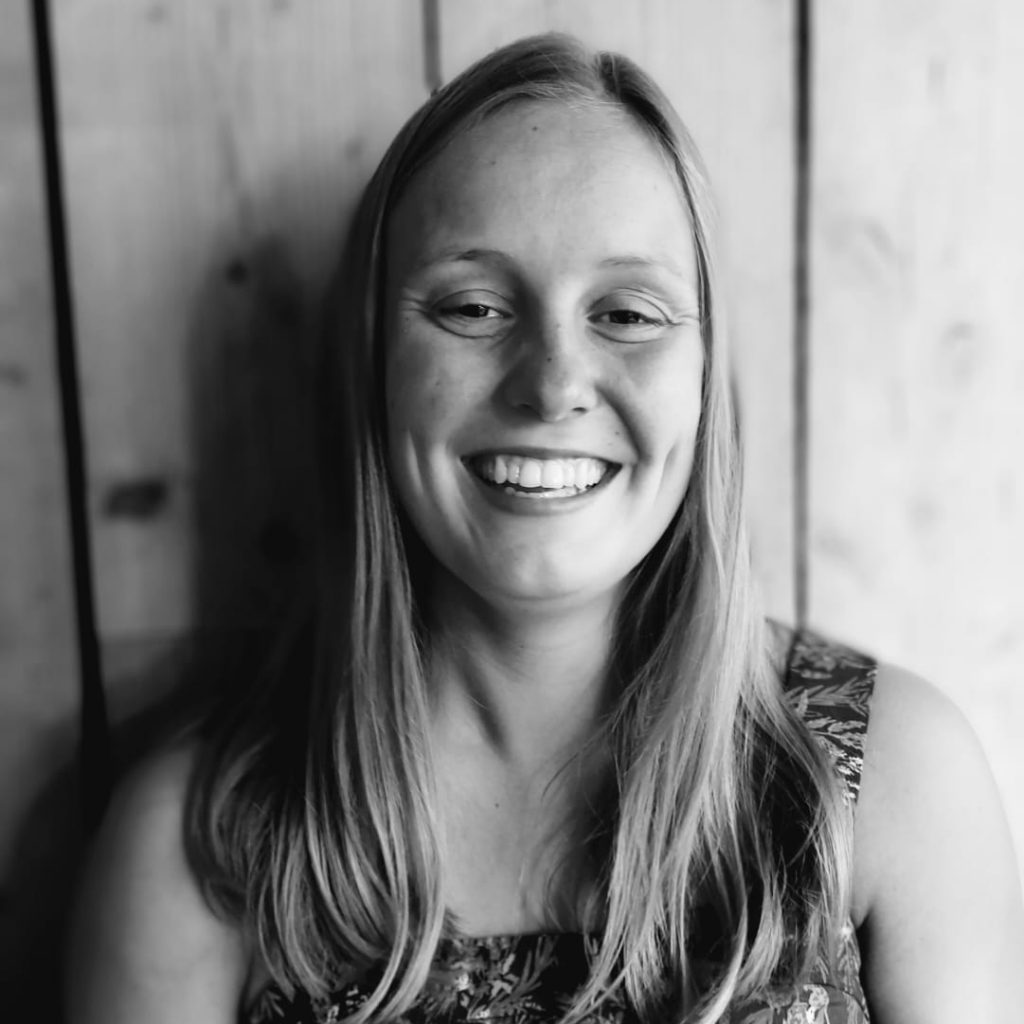
Julie Plas
Master’s degree in neurological physiotherapy in 2020
Specialisations:
- Neurology
- Shockwave therapy

Charbel Merheb
General master’s degree in physiotherapy in 2024
Specialisations:
- Myofascial complaints
- Dry Needling
- Shockwave therapy
Contact
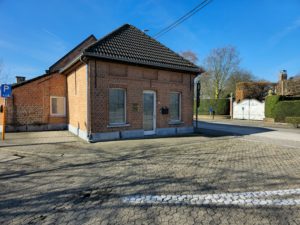
Location
VITSSTRAAT 70
9255 OPDORP (BUGGENHOUT)
Phone
VAT
BE0804.986.370
